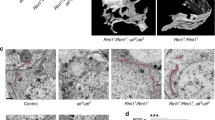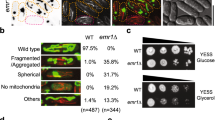Abstract
Although studies on endoplasmic reticulum (ER) structure and dynamics have focused on the ER tubule-forming proteins (reticulons and DP1/Yop1p) and the tubule fusion protein atlastin, nothing is known about the proteins and processes that act to counterbalance this machinery. Here we show that Lnp1p, a member of the conserved Lunapark family, plays a role in ER network formation. Lnp1p binds to the reticulons and Yop1p and resides at ER tubule junctions in both yeast and mammalian cells. In the yeast Saccharomyces cerevisiae, the interaction of Lnp1p with the reticulon protein, Rtn1p, and the localization of Lnp1p to ER junctions are regulated by Sey1p, the yeast orthologue of atlastin. We propose that Lnp1p and Sey1p act antagonistically to balance polygonal network formation. In support of this proposal, we show that the collapsed, densely reticulated ER network in lnp1 Δ cells is partially restored when the GTPase activity of Sey1p is abrogated.
This is a preview of subscription content, access via your institution
Access options
Subscribe to this journal
Receive 12 print issues and online access
$209.00 per year
only $17.42 per issue
Buy this article
- Purchase on Springer Link
- Instant access to full article PDF
Prices may be subject to local taxes which are calculated during checkout








Similar content being viewed by others
References
Du, Y., Ferro-Novick, S. & Novick, P. Dynamics and inheritance of the endoplasmic reticulum. J. Cell Sci. 117, 2871–2878 (2004).
Voeltz, G. K., Prinz, W. A., Shibata, Y., Rist, J. M. & Rapoport, T. A. A class of membrane proteins shaping the tubular endoplasmic reticulum. Cell 124, 573–586 (2006).
Lee, C. & Chen, L. B. Dynamic behavior of endoplasmic reticulum in living cells. Cell 54, 37–46 (1988).
De Craene, J. O. et al. Rtn1p is involved in structuring the cortical endoplasmic reticulum. Mol. Biol. Cell 17, 3009–3020 (2006).
Hu, J. et al. Membrane proteins of the endoplasmic reticulum induce high-curvature tubules. Science 319, 1247–1250 (2008).
Hu, J. et al. A class of dynamin-like GTPases involved in the generation of the tubular ER network. Cell 138, 549–561 (2009).
West, M., Zurek, N., Hoenger, A. & Voeltz, G. K. A 3D analysis of yeast ER structure reveals how ER domains are organized by membrane curvature. J. Cell. Biol. 193, 333–346 (2011).
Schuck, S., Prinz, W. A., Thorn, K. S., Voss, C. & Walter, P. Membrane expansion alleviates endoplasmic reticulum stress independently of the unfolded protein response. J. Cell. Biol. 187, 525–536 (2009).
Orso, G. et al. Homotypic fusion of ER membranes requires the dynamin-like GTPase atlastin. Nature 460, 978–983 (2009).
Park, S. H., Zhu, P. P., Parker, R. L. & Blackstone, C. Hereditary spastic paraplegia proteins REEP1, spastin, and atlastin-1 coordinate microtubule interactions with the tubular ER network. J. Clin. Invest. 120, 1097–1110 (2010).
Beetz, C. et al. REEP1 mutation spectrum and genotype/phenotype correlation in hereditary spastic paraplegia type 31. Brain 131, 1078–1086 (2008).
Salinas, S., Proukakis, C., Crosby, A. & Warner, T. T. Hereditary spastic paraplegia: clinical features and pathogenetic mechanisms. Lancet. Neurol. 7, 1127–1138 (2008).
Spitz, F., Gonzalez, F. & Duboule, D. A global control region defines a chromosomal regulatory landscape containing the HoxD cluster. Cell 113, 405–417 (2003).
Du, Y., Pypaert, M., Novick, P. & Ferro-Novick, S. Aux1p/Swa2p is required for cortical endoplasmic reticulum inheritance in Saccharomyces cerevisiae. Mol. Biol. Cell 12, 2614–2628 (2001).
Estrada, P. et al. Myo4p and She3p are required for cortical ER inheritance in Saccharomyces cerevisiae. J. Cell Biol. 163, 1255–1266 (2003).
Prinz, W. A. et al. Mutants affecting the structure of the cortical endoplasmic reticulum in Saccharomyces cerevisiae. J. Cell Biol. 150, 461–474 (2000).
Shibata, Y. et al. Mechanisms determining the morphology of the peripheral ER. Cell 143, 774–788 (2010).
Loewen, C. J., Young, B. P., Tavassoli, S. & Levine, T. P. Inheritance of cortical ER in yeast is required for normal septin organization. J. Cell Biol. 179, 467–483 (2007).
Barrowman, J., Sacher, M. & Ferro-Novick, S. TRAPP stably associates with the Golgi and is required for vesicle docking. EMBO J. 19, 862–869 (2000).
Grote, E. Cell fusion assays for yeast mating pairs. Methods Mol. Biol. 475, 165–196 (2008).
Moss, T. J., Andreazza, C., Verma, A., Daga, A. & McNew, J. A. Membrane fusion by the GTPase atlastin requires a conserved C-terminal cytoplasmic tail and dimerization through the middle domain. Proc. Natl Acad. Sci. USA 108, 11133–11138 (2011).
Ghila, L. & Gomez, M. The evolutionarily conserved gene LNP- 1 is required for synaptic vesicle trafficking and synaptic transmission. Eur. J. Neurosci. 27, 621–630 (2008).
Hoppins, S., Lackner, L. & Nunnari, J. The machines that divide and fuse mitochondria. Annu. Rev. Biochem. 76, 751–780 (2007).
Bleazard, W. et al. The dynamin-related GTPase Dnm1 regulates mitochondrial fission in yeast. Nat. Cell Biol. 1, 298–304 (1999).
Hales, K. G. & Fuller, M. T. Developmentally regulated mitochondrialfusion mediated by a conserved, novel, predicted GTPase. Cell 90, 121–129 (1997).
Hermann, G. J. et al. Mitochondrial fusion in yeast requires the transmembrane GTPase Fzo1p. J. Cell Biol. 143, 359–373 (1998).
Ruohola, H., Kabcenell, A. K. & Ferro-Novick, S. Reconstitution of protein transport from the endoplasmic reticulum to the Golgi complex in yeast: the acceptor Golgi compartment is defective in the sec23 mutant. J. Cell Biol. 107, 1465–1476 (1988).
Acknowledgements
We thank G. Voeltz (Department of Molecular, Cellular and Developmental Biology, University of Colorado at Boulder, USA) for plasmids. We also thank Y. Jones in the Electron Microscopy Facility in the Department of Cellular and Molecular Medicine at the University of California at San Diego, USA, headed by M. Farquhar, for the preparation of electron microscopy samples, and we acknowledge use of the UCSD Neuroscience Microscopy Facility funded by grant P30 NS047101. This work was supported by a grant from the National Institutes of Health (GM073892) and the Howard Hughes Medical Institute. Salary support for S.C. and S.F-N. was provided by the Howard Hughes Medical Institute.
Author information
Authors and Affiliations
Contributions
S.F-N. and P.N. conceived the idea for the screen. S.F-N., P.N. and S.C. designed the experiments, analysed the data and wrote the manuscript. S.C. performed the research.
Corresponding authors
Ethics declarations
Competing interests
The authors declare no competing financial interests.
Supplementary information
Supplementary Information
Supplementary Information (PDF 2477 kb)
Supplementary Table 1
Supplementary Information (XLSX 21 kb)
Rights and permissions
About this article
Cite this article
Chen, S., Novick, P. & Ferro-Novick, S. ER network formation requires a balance of the dynamin-like GTPase Sey1p and the Lunapark family member Lnp1p. Nat Cell Biol 14, 707–716 (2012). https://doi.org/10.1038/ncb2523
Received:
Accepted:
Published:
Issue Date:
DOI: https://doi.org/10.1038/ncb2523
This article is cited by
-
Assembloid CRISPR screens reveal impact of disease genes in human neurodevelopment
Nature (2023)
-
Dynamics of CLIMP-63 S-acylation control ER morphology
Nature Communications (2023)
-
A Review of Mechanics-Based Mesoscopic Membrane Remodeling Methods: Capturing Both the Physics and the Chemical Diversity
The Journal of Membrane Biology (2022)
-
Maternal obesity during pregnancy leads to adipose tissue ER stress in mice via miR-126-mediated reduction in Lunapark
Diabetologia (2021)
-
Membrane and organelle dynamics during cell division
Nature Reviews Molecular Cell Biology (2020)



